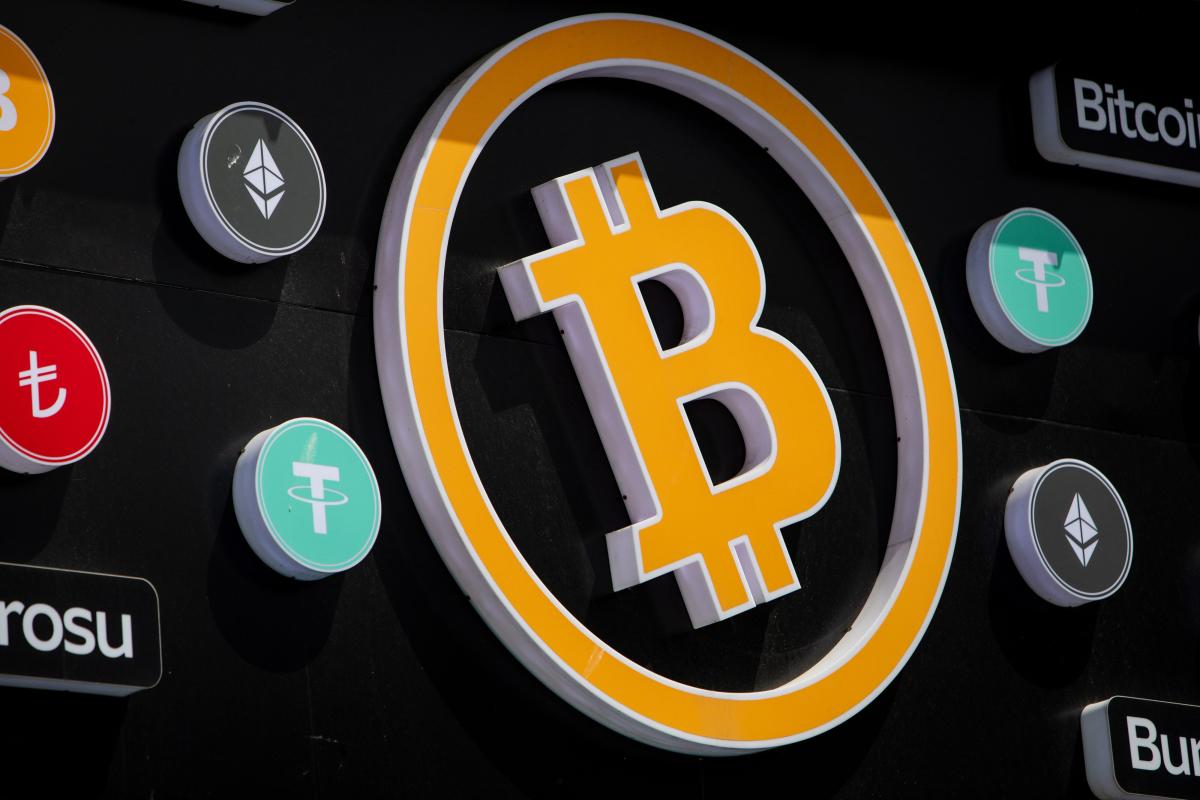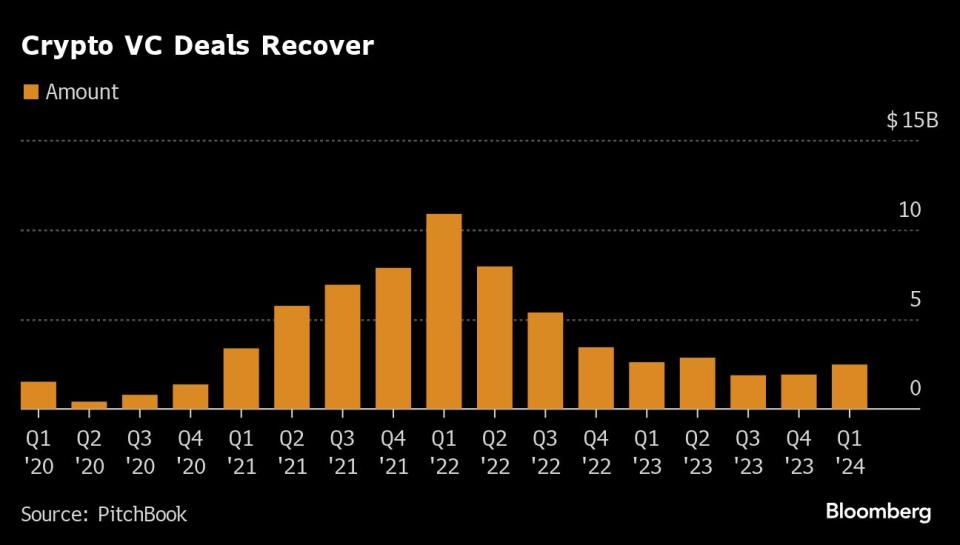News
A familiar road to instant cryptocurrency gains reopens

(Bloomberg) — Cryptocurrency markets boomed in March as Bitcoin hit a record high and billions of dollars flowed into new ETFs. But one particular group of investors had more reason to cheer than most.
Most read by Bloomberg
At the time, startup Monad Labs was closing in on a funding round in which venture capital investors including Paradigm valued it at $3 billion. While important by crypto standards, the Monad deal had another distinguishing feature: Some people known in the industry as “key opinion leaders” were allowed to invest at a fifth of Paradigm’s valuation, people familiar with the matter said .
These “KOL rounds,” which bear similarities to the celebrity deals that U.S. regulators have cracked down on in recent years, have proliferated as digital assets recover from a bear market. This time, the investors getting sweetened terms are more likely to be cryptocurrency bloggers than athletes or reality TV stars.
In exchange for promoting crypto projects, KOLs typically get favorable terms such as valuation discounts and shorter vesting periods, according to interviews with influencers, entrepreneurs and legal experts. The deals have become a source of controversy, with critics focusing on poor disclosure and potential risks to retail investors.
At least some startups raising money do not require influencers to disclose their affiliations, several people familiar with such arrangements said — an apparent violation of U.S. regulations.
There is no indication that Monad Labs’ fundraising violated U.S. securities rules. One investor said the company did not impose any explicit requirements on KOLs. Chief Executive Keone Hon declined to comment on what vesting terms and disclosure rules applied to such investors.
San Francisco-based Paradigm, which runs one of the largest cryptocurrency funds, also declined to comment.
Influencers and cryptocurrencies
“Projects that include opinion leaders and key influencers in a funding round with the expectation that such individuals will go out and promote the project token as an investment may be scrutinized by the Securities and Exchange Commission,” Michael Selig, partner at Willkie Farr & Gallagher LLP, which specializes in securities law, said in an email.
The story continues
KOL rounds exist in part because of some unique characteristics of cryptocurrency markets. While some digital asset startups offer equity capital to raise venture capital funds, others do so by selling the tokens they issue or are affiliated with. The project’s valuation becomes a function of the number of coins sold and their price, similar to a stock sale. There are also hybrid funding rounds that mix tokens and equity, such as Monad Labs.
Buying tokens typically doesn’t offer investors the same protection that equity rounds do, but it offers one big advantage: the ability to sell them in just months, whereas equity investors are often locked in for years before a liquidity event like a ‘IPO. .
Then there is the role that influencers play in cryptocurrency markets. For years, cryptocurrencies have nurtured a cottage industry of famous people ranging from reality stars to athletes and self-proclaimed experts promoting projects online. During the initial coin offering boom of 2017, a large following on “crypto Twitter” could be a ticket to instant riches, in the form of early access to hot tokens and compensation for advertising them.
“Making So Much Money”
It doesn’t always take a lot of following to qualify as a KOL investor.
“Almost anyone with an influence or a community,” said Simon Chadwick, co-founder of crypto platform Eclipse Fi. “It could be someone who has 5,000 people on Twitter and who writes search threads,” he said, referring to the social media platform now known as X.
Eclipse Fi helps projects based on a blockchain called Cosmos launch tokens. To streamline this process, the company has a network of more than 400 KOL investors that startups can tap into, Chadwick said. The potential for quick returns is so great that some influencers try to use fake social media accounts so they can invest in the same funding round multiple times, he said.
According to Chadwick, KOLs in these types of deals can get discounts of 20% to 50% and shorter vesting terms, meaning they can sell their tokens sooner than other investors.
“Some of these KOLs are investing in hundreds of rounds, making so much money,” he said.
The SEC has cracked down on influencer marketing by crypto projects. In October 2022, Kim Kardashian agreed to pay $1.3 million to resolve regulator allegations that she broke US rules by promoting a digital token without disclosing that she was paid to do so. She neither admitted nor denied the charges. Four years earlier, the SEC had fined Floyd Mayweather for failing to disclose a similar crypto deal.

HAMBURG, GERMANY – MAY 7: Kim Kardashian on stage during OMR Festival 2024 on May 7, 2024 in Hamburg, Germany. (Photo by Tristar Media/Getty Images) (Tristar Media via Getty Images)
Emily Meyers, general counsel and chief compliance officer at cryptocurrency fund Electric Capital, said she will caution projects against KOL rounds in light of the SEC’s actions against Kardashian and a similar case last year, in which the regulator accused eight celebrities, including Lindsay Lohan, of failing to disclose that they were paid to promote tokens.
Six of the accused celebrities, including Lohan, settled the case without admitting or denying the SEC’s allegations.
The SEC did not respond to a request for comment on the influencer rings.
“Pump-and-Dumping”
Regardless of the regulatory implications, KOL rounds are becoming controversial in the cryptocurrency industry.
One crypto influencer, who posts on CL, who is based outside the United States and asked that his identity not be used due to the sensitivity of the subject, said it has avoided such deals because of the potential reputational risk.
The surge in KOL deals is “an extension of the pump-and-dumping of small-market-cap tokens, but on a larger scale,” said CL, who has nearly 200,000 followers on X. Influencers’ investments in such deals are often fast-tracked by a “well-known institution” to lend legitimacy to the project and raise prices, CL said.
KOLs are generally willing to accept longer vesting periods in larger deals with large venture capital backers, Eclipse Fi’s Chadwick said. On the other hand, they tend to ask for larger discounts in such transactions, she said.


Because details on influencer purchases are often “difficult to obtain,” venture capital data compilers do not provide separate reports on KOL rounds, said Orla Browne, head of insights at Dealroom.
They often take different forms, with some agreements involving written contracts outlining what KOLs should do in terms of promotions while others are made via Telegram. Some are part of VC-backed funding rounds; others are early-stage projects, not yet mature enough to court major institutions.
While most KOL trades are entirely token-based, some feature a combination of shares and warrants for yet-to-launch digital coins.
A written contract for a KOL funding round, a redacted copy of which was seen by Bloomberg News, specified that influencers who invested at a discount must promote the project through formats ranging from long-form podcasts to TikTok videos. The agreement stipulates that KOLs must disclose their affiliation with the project when advertising it.
But many other projects do not.
“It’s not a requirement,” said 0xJeff, who runs crypto consultancy Steak Capital, which lists “KOL management” among its services. “It really depends on the KOL side whether they want to let the community know that they are invested in the project and that they are affiliated with the project or not,” said OxJeff, who as CL tweets anonymously and asked that their real name not be used .
Diffusion of discomfort
Larger crypto projects typically don’t make explicit requests of KOL investors, said Jed Breed, founder of Breed VC. Instead, such broadcasters aim to create what he called a “whisper network” among the crypto-influencer community. “I’ve never seen a VC deal where it’s like, ‘if you want this allocation, you have to do X, Y, Z,’” Breed said.
Some startups are so interesting that they don’t need to offer heavily sugarcoated terms to KOLs.
Humanity Protocol, which is building a blockchain network that uses people’s palm prints to verify their identity, raised funding at a $1 billion valuation this month from venture capital investors such as Animoca Brands. KOLs invested about $1.5 million in March, but they did so “literally on the same terms as some VCs” and their investments were limited to $25,000 per person, Humanity founder Terence Kwok said.
Joshua Cheong, a product engineer at Parity Technologies who participated as a KOL in Monad Labs’ funding round, said the company didn’t require him to promote the project when he invested. He declined to comment on the valuation and vesting period.
According to OxJeff, US-based influencers are more wary of potential SEC scrutiny and tend to disclose their affiliations when promoting a project or token.
But disruption is starting to creep in throughout the community, regardless of where people are located, OxJeff said. That’s largely because ZachXBT, an influential tweeter with nearly 600,000 X followers whose handle describes him as a “rug survivor,” has begun publicly criticizing the KOL deals.
“I’d be lying if I said KOLs weren’t worried, right? All the KOLs are worried,” OxJeff said. “Especially in these days when there are too many KOL rounds and many don’t do so well.”
Most read by Bloomberg Businessweek
©2024 Bloomberg LP
News
Cryptocurrency Price August 1: Bitcoin Dips Below $65K; Solana, XRP Down Up To 8%

Major cryptocurrencies fell in Thursday trading following the Federal Reserve’s decision to keep its key interest rate unchanged. Overnight, the U.S. Federal Reserve kept its key interest rate at 5.25-5.5% for the eighth consecutive time, as expected, while also signaling the possibility of a rate cut at its next meeting in September. The unanimous decision by the Federal Open Market Committee reflects a continued wait-and-see approach as it monitors inflation trends.
CoinSwitch Markets Desk said: “Bitcoin has fallen below $65,000 after the US Federal Reserve announced it would keep interest rates unchanged. However, with markets now anticipating rate cuts at the next Federal Reserve meeting in September, the outlook for a Bitcoin rally by the end of the year has strengthened.”
Meanwhile, CoinDCX research team said: “The crypto market has plunged after the Fed decision. Tomorrow’s US unemployment rate announcement is expected to induce more volatility, with the ‘actual’ figure coming in higher than the ‘expected’ one, which is positive for cryptocurrencies.”
At 12:21 pm IST, Bitcoin (BTC) was down 3.2% at $64,285, while Ethereum was down nearly 4.5% at $3,313. Meanwhile, the global market cryptocurrency The market capitalization fell 3.6% to around $2.3 trillion in the last 24 hours.
“Bitcoin needs to clear its 200-day EMA at $64,510 to consolidate further. Otherwise, a retest of $62,000 could be in the cards,” said Vikram Subburaj, CEO of Giottus.
Altcoins and meme coins, such as BNB (3%), Solana (8%), XRP (5.7%), Dogecoin (5%), Cardano (4.6%), Avalanche (4.3%), Shiba Inu (3.8%), Polkadot (3.4%), and Chainlink (4%) also saw declines.
The volume of all stablecoins is now $71.64 billion, which is 92.19% of the total cryptocurrency market volume in 24 hours, according to data available on CoinMarketCap. Bitcoin’s dominance is currently 54.99%. BTC volume in the last 24 hours increased by 23.3% to $35.7 billion.
(Disclaimer: Recommendations, suggestions, opinions and views provided by experts are personal. They do not represent the views of the Economic Times)
(You can now subscribe to our ETMarkets WhatsApp Channel)
News
Altcoins WIF, BONK, RUNE, JUP Down 10% While Bitcoin Drops 4%

Altcoins dogwifhat, Bonk, THORChain, and Jupiter have suffered losses of more than 10%, while Bitcoin is down 4% in the last 24 hours.
After a period of relative calm yesterday, July 31, Bitcoin (BTC) price action has seen a drastic change as the cryptocurrency dropped by more than $3,500, bringing its value to $63,300. At the same time, altcoins mirrored this trend, with the total value of liquidated positions rising to nearly $225 million over the course of the day.
Initially, the week started on a positive note for Bitcoin, which reached its highest point since early June, hitting $70,000. However, this peak was short-lived, as it was quickly rejected, leading to a substantial decline, with Bitcoin falling below $65,500.
The cryptocurrency managed to regain some stability, trading comfortably at around $66,800. However, following a Press conference According to Federal Reserve Chairman Jerome Powell, the value of Bitcoin has fallen again to $64,300, down more than 3% in 24 hours.
BTC Price Chart 24 Hours | Source: crypto.news
The recession coincided with a relationship from the New York Times stating that Iran had called for retaliatory measures against Israel following the assassination of Hamas leader Ismail Haniyeh in Tehran, increasing the risk of further conflict in the region.
Meanwhile, on the economic front, the Federal Reserve decided to keep its benchmark interest rates in place, offering little information on a planned September rate cut. Powell also hinted that while no concrete decisions have been made on the September adjustment, there is growing consensus that a rate cut is likely.
Amid Bitcoin’s decline, altcoins have suffered even more significant losses. For example, dogwifhat (Wife) saw a 12.4% drop and (DISGUST) has suffered a 10% drop. Other altcoins such as THORChain (RUNE) also fell by 10%, while Jupiter (JUPITER) and the Ethereum naming service (ENS) decreased by 8% and 9% respectively.
Among the largest-cap cryptocurrencies, the biggest losers are Solana (SOL) with a decrease of 8%, (Exchange rate risk) down 6%, Cardano (ADA) down 4%, and both Ethereum (ETH) and Dogecoin (DOGE) recording a decrease of 4.4%.
Data from CoinGlass indicates that approximately 67,000 traders have been negatively impacted by this increased volatility. BTC positions have seen $61.85 million in liquidations, while ETH positions have faced $61 million. In total, the value of liquidated positions stands at $225.4 million at the time of writing.
News
Riot Platforms Sees 52% Drop in Bitcoin Production in Q2

Bitcoin mining firm Riot Platforms has released its second-quarter financial results, highlighting a decline in cryptocurrency mined due to the recent halving.
Colorado-based Bitcoin (BTC) mining company Riot platforms revealed its second quarter financial results, highlighting a significant reduction in mined cryptocurrencies attributed to the recent halving event that took place in early April.
The company reported total revenue of $70 million for the quarter ended July 31, a decline of 8.7% compared to the same period in 2023. Riot Platforms attributed the revenue decline primarily to a $9.7 million decrease in engineering revenue, which was partially mitigated by a $6 million increase in Bitcoin extraction income.
During the quarter, the company mined 844 BTC, representing a decline of over 50% from Q2 2023, citing the halving event and increasing network difficulty as major factors behind the decline. Riot Platforms reported a net loss of $84.4 million, or $0.32 per share, missing Zacks Research forecast a loss of $0.16 per share.
Halving increases competitive pressure
The Colorado-based firm said the average cost of mining one BTC in the second quarter, including energy credits, rose to $25,327, a remarkable 341% increase from $5,734 per BTC in the same quarter of 2023. Despite this significant increase in production costs, the firm remains optimistic about maintaining competitiveness through recent deals.
For example, following the Recent acquisition Cryptocurrency firm Block Mining, Riot has increased its distributed hash rate forecast from 31 EH/s to 36 EH/s by the end of 2024, while also increasing its 2025 forecast from 40 EH/s to 56 EH/s.
Riot Platforms Hashrate Growth Projections by 2027 | Source: Riot Platforms
Commenting on the company’s financials, Riot CEO Jason Les said that despite the halving, the mining company still managed to achieve “significant operational growth and execution of our long-term strategy.”
“Despite this reduction in production available to all Bitcoin miners, Riot reported $70 million in revenue for the quarter and maintained strong gross margins in our core Bitcoin mining business.”
Jason Les
Following its Q2 financial report, Riot Platforms shares fell 1.74% to $10.19, according to Google Finance data. Meanwhile, the American miner continues to chase Canadian rival Bitfarms, recently acquiring an additional 10.2 million BITF shares, increasing its stake in Bitfarms to 15.9%.
As previously reported by crypto.news, Riot was the first announced a $950 million takeover bid for Bitfarms in late May, arguing that Bitfarms’ founders were not acting in the best interests of all shareholders. They said their proposal was rejected by Bitfarms’ board without substantive engagement.
In response, Bitfarms She said that Riot’s offer “significantly understates” its growth prospects. Bitfarms subsequently implemented a shareholder rights plan, also known as a “poison pill,” to protect its strategic review process from hostile takeover attempts.
News
Aave Price Increases Following Whales Accumulation and V3.1 Launch

Decentralized finance protocol Aave is seeing a significant spike in whale activity as the market looks to recover from the recent crash that pushed most altcoins into key support areas earlier this week.
July 31, Lookonchain shared details indicating that the whales had aggressively accumulated Aave (AAVE) over the past two days. According to the data, whales have withdrawn over 58,848 AAVE worth $6.47 million from exchanges during this period.
In one instance, whale address 0x9af4 withdrew 11,185 AAVE worth $1.23 million from Binance. Meanwhile, another address moved 21,619 AAVE worth over $2.38 million from the exchange and deposited the tokens into Aave.
These withdrawals follow a previous transfer of 26,044 AAVE from whale address 0xd7c5, amounting to over $2.83 million withdrawn from Binance.
AAVE price has surged over 7% in the past 24 hours amid buy-side pressure from these whales. The DeFi token is currently trading around $111 after jumping over 18% in the past week.
Recently, the price of AAVE increased by over 8% after Aave founder Marc Zeller announced a proposed fee change aimed at adopting a buyback program for AAVE tokens.
Aave v3.1 is available
The total value locked in the Aave protocol currently stands at around $22 billion. According to DeFiLlamaApproximately $19.9 billion is on Aave V3, while the V2 chain still holds approximately $1.9 billion in TVL and V1 approximately $14.6 million.
Aave Labs announced Previously, Aave V3.1 was made available on all networks with active Aave V3 instances.
V3.1 features improvements that are intended to improve the overall security of the DeFi protocol. The Aave DAO governance has approved the v3.1 improvements, which also include operational efficiency and usability for the network.
Meanwhile, Aave Labs recently outlined a ambitious roadmap for the projectwith a 2030 vision for Aave V4, among other developments.
-

 Regulation12 months ago
Regulation12 months agoRipple CTO and Cardano founder clash over XRP’s regulatory challenges ⋆ ZyCrypto
-

 Regulation10 months ago
Regulation10 months agoNancy Pelosi Considers Supporting Republican Crypto Bill FIT21 – London Business News
-

 Videos11 months ago
Videos11 months agoCryptocurrency News: Bitcoin, ETH ETF, AI Crypto Rally, AKT, TON & MORE!!
-

 Regulation11 months ago
Regulation11 months agoBitcoin’s future is ‘bleak’ and ripe for regulation, says lead developer
-

 News9 months ago
News9 months agoAave Price Increases Following Whales Accumulation and V3.1 Launch
-

 Regulation9 months ago
Regulation9 months agoSouth Korea Imposes New ‘Monitoring’ Fees on Cryptocurrency Exchanges
-

 Regulation9 months ago
Regulation9 months agoA Blank Sheet for Cryptocurrencies: Kamala Harris’ Regulatory Opportunity
-

 Regulation9 months ago
Regulation9 months agoCryptocurrency Regulations in Slovenia 2024
-

 News11 months ago
News11 months agoThe trader earned $46 million with PEPE after reaching a new ATH
-

 Regulation11 months ago
Regulation11 months agoCrypto needs regulation to thrive: Tyler Cowen
-

 Blockchain11 months ago
Blockchain11 months agoSolana ranks the fastest blockchain in the world, surpassing Ethereum, Polygon ⋆ ZyCrypto
-

 Blockchain11 months ago
Blockchain11 months agoSolana Surpasses Ethereum and Polygon as the Fastest Blockchain ⋆ ZyCrypto

















